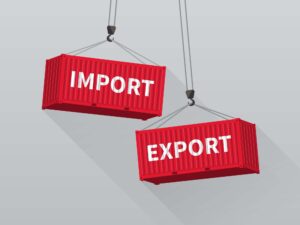Introduction to Textiles Industry
The global smart textiles industry has witnessed remarkable growth in recent years, fueled by innovation in wearable technology, trade in new materials, and shifts in the fashion and technology sectors. As this industry continues to evolve, its impact extends beyond its immediate domain, affecting various sectors, including the foreign exchange (forex) markets. This article delves into the intricate relationship between the smart textiles industry and forex markets, highlighting key factors that influence exchange rates and trade dynamics.
Section 1: Innovation in Wearable Technology

Section 2: Trade in New Materials
In the dynamic landscape of the smart textiles industry, innovations frequently hinge on the use of cutting-edge materials. As companies continuously explore novel materials for their smart textile products, these endeavors have a far-reaching impact on international trade dynamics. This section explores the intricate relationship between the smart textiles industry and forex markets concerning trade in new materials:
2.1 Material Imports and Exports:

Example: A company like XYZ Textiles develops a groundbreaking fabric technology that is sourced from a specific country. Increased demand for this material can boost that country’s currency value against others, affecting exchange rates.
Innovations in smart textiles often require the integration of advanced materials that may not be widely available globally. When a company, such as XYZ Textiles, pioneers a breakthrough in fabric technology and relies on a particular country as its primary source for these materials, it can lead to significant shifts in international trade dynamics.
As demand for these specialized materials surges due to their unique application in the smart textiles industry, the country supplying these materials experiences increased export volumes. This heightened demand can result in an appreciation of the supplying country’s currency relative to other currencies. Investors and forex traders take note of these developments, as they signify an increase in the economic strength and export capacity of the supplying nation.
For instance, if XYZ Textiles sources a specialized conductive fabric from Country A for its innovative smart clothing line, and demand for this fabric skyrockets due to its unique properties, Country A’s currency may strengthen as it enjoys a surge in exports. This, in turn, can impact the exchange rate between Country A’s currency and other major currencies in the forex market.
2.2 Trade Agreements:
Example: International trade agreements, such as those related to intellectual property rights and tariffs on smart textile materials, can impact the cost structure of the industry. Any changes in these agreements may lead to currency fluctuations.
The smart textiles industry’s cost structure is intimately linked with international trade agreements and policies. These agreements encompass a wide range of issues, including intellectual property rights, tariffs on materials used in smart textiles, and regulations governing cross-border trade. Changes in these agreements can significantly influence the industry’s operating costs, which, in turn, affect currency exchange rates:
- Intellectual Property Rights: Innovations in the smart textiles industry are often protected by intellectual property rights, such as patents and trademarks. Alterations to these rights, such as the issuance of new patents or changes in the enforcement of existing ones, can impact the competitive landscape. If a company secures a significant patent for a breakthrough smart textile technology, it may gain a competitive advantage, leading to increased demand for its products. Consequently, the currency of the country where the company is based could appreciate as a result of its enhanced export potential.
- Tariffs on Smart Textile Materials: The imposition or reduction of tariffs on materials used in smart textiles can have a profound effect on production costs. For instance, if a country lowers tariffs on critical materials for smart textiles, it may encourage domestic production and stimulate demand for its currency. Conversely, higher tariffs on these materials can lead to increased costs for smart textiles manufacturers and potentially weaken their competitiveness in international markets.
- Regulations and Compliance: Changes in regulations related to environmental standards, safety requirements, or labeling for smart textile products can affect production processes and costs. Compliance with new regulations may necessitate adjustments in manufacturing methods, which can impact both domestic and international demand for smart textiles, influencing currency exchange rates accordingly.
In conclusion, trade in new materials plays a pivotal role in the smart textiles industry’s growth and its impact on forex markets. As companies leverage innovative materials for their products, shifts in demand, supply, and trade agreements can lead to significant fluctuations in currency exchange rates. Forex traders and investors must remain vigilant about evolving international trade dynamics and their potential implications for the smart textiles industry and the broader global economy.
Section 3: Shifts in the Fashion and Technology Sectors

The smart textiles industry occupies a unique position at the confluence of fashion and technology. Changes and developments in either of these sectors can reverberate through the foreign exchange (forex) markets, affecting currency exchange rates and trade dynamics. This section examines the interplay between the smart textiles industry and forex markets in response to shifts in the fashion and technology sectors:
3.1 Fashion Trends and Consumer Behavior:
Example: Rapid changes in fashion trends influence the demand for smart clothing and accessories. This demand can impact the currency values of countries known for their fashion industries.
Fashion trends are notorious for their dynamism, with consumer preferences and styles evolving at a rapid pace. The incorporation of smart textiles into fashion has created a symbiotic relationship between the two industries. As consumers seek fashionable clothing and accessories embedded with cutting-edge technology, shifts in fashion trends can have direct consequences for the smart textiles industry and, consequently, forex markets:
- Consumer Demand for Smart Fashion: When a particular style or trend becomes popular, there is often a corresponding surge in demand for smart clothing and accessories that align with that trend. For instance, a trend favoring sustainable and eco-friendly fashion may drive demand for smart textiles that incorporate environmentally conscious materials and technologies. This heightened demand can lead to increased production and exports from countries known for their fashion industries.
- Impact on Currency Values: Countries renowned for their fashion industries, such as France, Italy, and the United States, often experience an upswing in export revenues when fashion trends favor their products. As these countries witness an increase in export demand for smart textiles and fashion tech products, their currencies may appreciate in value relative to other currencies. Forex traders closely monitor these shifts in consumer behavior and fashion trends as they can influence currency exchange rates.
For example, if a new fashion trend centered around smart clothing emerges, leading to a surge in demand for products from a particular country, the currency of that country may strengthen in response to increased exports. This could affect the forex market’s perception of the relative strength of currencies and influence exchange rates.
3.2 Technological Advancements:
Example: Technological breakthroughs in other sectors, such as semiconductor manufacturing, can indirectly influence the smart textiles industry. A major advancement in semiconductors may affect the currency values of countries leading in semiconductor production.
The smart textiles industry relies heavily on technological advancements across various sectors. Technological breakthroughs can enhance the capabilities and functionalities of smart textile products, indirectly impacting forex markets through their effects on the industry:
- Semiconductor Manufacturing: Semiconductors play a crucial role in the development of smart textiles, powering sensors, processors, and connectivity components. Any major advancements in semiconductor manufacturing can translate into improved performance and lower production costs for smart textile devices.
- Impact on Export Competitiveness: Countries that are leaders in semiconductor manufacturing, such as South Korea or Taiwan, can experience increased competitiveness in global markets. A stronger semiconductor industry can stimulate higher export volumes and greater demand for the currency of the country at the forefront of this technological sector.
- Supply Chain Interdependencies: Smart textiles manufacturers often rely on global supply chains that span multiple sectors. A breakthrough in semiconductor technology may lead to increased demand for certain components, affecting supply chain dynamics and impacting the currency exchange rates of countries involved in these supply chains.
For instance, if there is a major advancement in semiconductor manufacturing that results in more efficient and cost-effective chips, smart textile companies using these chips may benefit from reduced production costs. This, in turn, can enhance their competitiveness in global markets and potentially boost demand for the currency of the country where these companies are based.
In conclusion, the smart textiles industry’s position at the intersection of fashion and technology makes it particularly sensitive to shifts in both sectors. Changes in fashion trends and consumer behavior can influence demand for smart textile products, affecting the export potential of countries known for their fashion industries. Additionally, technological advancements, especially in sectors like semiconductor manufacturing, can indirectly impact the smart textiles industry, leading to fluctuations in currency exchange rates. Forex market participants must remain vigilant about these interconnected influences to make informed trading decisions in an ever-evolving global economy.
Section 4: Challenges and Risks
The burgeoning growth of the smart textiles industry offers substantial opportunities but also introduces unique challenges and risks for forex markets. This section explores some of the key challenges and risks associated with this industry:
4.1 Volatility:
Example: Rapid technological advancements can lead to volatile swings in smart textiles stocks, impacting forex traders’ risk perceptions and trading strategies.
The smart textiles industry is characterized by its rapid pace of innovation and technological advancements. While these advancements drive the industry’s growth, they also introduce significant volatility to the forex markets:
- Stock Price Fluctuations: Companies within the smart textiles sector often experience rapid fluctuations in their stock prices in response to product launches, technological breakthroughs, or market sentiment. These fluctuations can lead to abrupt changes in market perceptions of risk and impact traders’ strategies.
- Investor Sentiment: The performance of smart textiles stocks can be heavily influenced by investor sentiment. Positive news about a breakthrough in smart textile technology can lead to a surge in investor optimism, driving up stock prices. Conversely, negative developments or missed expectations can trigger sharp declines. Forex traders closely monitor these stock price movements to gauge overall market sentiment and adjust their strategies accordingly.
- Impact on Currency Markets: The volatile swings in smart textiles stocks can spill over into currency markets as traders react to changes in risk perception. For example, during periods of heightened volatility in smart textiles stocks, investors may seek safe-haven currencies like the U.S. Dollar or Swiss Franc, causing these currencies to appreciate.
For instance, if a leading smart textiles company announces a groundbreaking innovation, its stock price may soar, prompting traders to reassess the risk landscape. In response, they may adjust their currency positions, potentially leading to currency exchange rate fluctuations.
4.2 Supply Chain Disruptions:
Example: Geopolitical tensions or natural disasters in regions critical to smart textiles supply chains can disrupt production and lead to currency market instability.
The smart textiles industry relies on intricate global supply chains for materials, production, and distribution. Any disruptions in these supply chains can have cascading effects on both the industry and forex markets:
- Geopolitical Tensions: Political instability, trade disputes, or sanctions involving countries crucial to the smart textiles supply chain can disrupt the flow of materials and components. Such disruptions can lead to production delays, increased costs, and potential shortages of smart textiles products. Forex traders closely monitor geopolitical developments as they can trigger currency market instability.
- Natural Disasters: Natural disasters, such as earthquakes, floods, or hurricanes, in regions that are integral to smart textiles production can disrupt manufacturing and distribution operations. This can lead to supply shortages and impact the value of currencies associated with affected regions.
- Currency Market Response: When supply chain disruptions occur, currency markets may react by reflecting the economic consequences of these disruptions. Currencies of countries directly affected may weaken due to reduced economic output, while currencies of countries benefiting from supply chain diversification may strengthen.
For example, if a significant earthquake disrupts production facilities in a region known for its smart textiles manufacturing, it can lead to production slowdowns or stoppages. This, in turn, may impact the currency of that region as its economic activity contracts. Meanwhile, countries that serve as alternative manufacturing hubs may experience a strengthening of their currencies as demand shifts to their facilities.
In conclusion, while the smart textiles industry offers immense potential, it also introduces challenges and risks to forex markets. Volatility in smart textiles stocks can affect traders’ risk perceptions and strategies, while supply chain disruptions caused by geopolitical tensions or natural disasters can lead to currency market instability. Forex market participants must remain vigilant and adaptable to navigate the ever-evolving landscape of the smart textiles industry and its associated risks.
Conclusion
The growing smart textiles industry is a dynamic force that influences forex markets in multifaceted ways. Innovations in wearable technology, trade in new materials, and shifts in the fashion and technology sectors all play a role in shaping exchange rates and trade dynamics. Investors and traders in the forex market must remain vigilant and adapt to the changing landscape created by the smart textiles industry to make informed decisions.
As this industry continues to evolve, its impact on global financial markets is likely to grow, making it an area of increasing importance for forex market participants to monitor closely. The interplay between innovation and exchange rates underscores the ever-evolving nature of the global economy.
Read our article on Asteroid Mining
FAQs
1. How does the smart textiles industry influence forex markets?
- The smart textiles industry influences forex markets through factors like consumer demand for smart clothing, stock performance of tech companies, trade in specialized materials, and supply chain dynamics.
2. Can fashion trends affect currency exchange rates?
- Yes, rapid changes in fashion trends can impact currency values, especially for countries known for their fashion industries. Increased demand for smart clothing and accessories can drive up exports, leading to currency appreciation.
3. How do technological advancements outside the smart textiles sector influence forex markets?
- Technological advancements in sectors like semiconductor manufacturing can indirectly affect the smart textiles industry and currency markets. A major breakthrough in semiconductors may boost the competitiveness of countries leading in semiconductor production.
4. Why is volatility in smart textiles stocks relevant to forex traders?
- Volatility in smart textiles stocks can alter traders’ risk perceptions and strategies. Positive or negative news about the industry can trigger abrupt changes in market sentiment, impacting currency exchange rates.
5. How can supply chain disruptions in the smart textiles industry impact forex markets?
- Geopolitical tensions or natural disasters in regions critical to smart textiles supply chains can disrupt production and lead to currency market instability. Currencies of affected regions may weaken, while those of alternative manufacturing hubs may strengthen.
6. Are there specific examples of fashion trends influencing currency values mentioned in the article?
- Yes, the article cites examples of how consumer demand for sustainable fashion trends can impact the currencies of countries known for their fashion industries.
7. How does the innovation in wearable technology relate to forex markets?
- Innovations in wearable technology can impact forex markets through their effects on consumer demand and the stock performance of tech companies like Apple and Google, which can influence exchange rates.
8. Are there specific companies mentioned in the article that are affected by supply chain dynamics?
- The article provides examples of hypothetical companies like “XYZ Textiles” to illustrate how supply chain dynamics can impact currency exchange rates.
9. Can you provide an example of how trade agreements can influence the cost structure of the smart textiles industry and currency exchange rates?
- The article mentions how changes in international trade agreements, such as those related to tariffs on smart textile materials, can impact production costs for the industry. This, in turn, can influence currency exchange rates.
10. How do forex traders respond to shifts in fashion trends and technological advancements in the smart textiles industry?
- Forex traders closely monitor developments in fashion trends, technological advancements, and stock performances of relevant companies to assess risk and make informed trading decisions based on changing market dynamics.
Click here to read more on Global Textiles Industry

